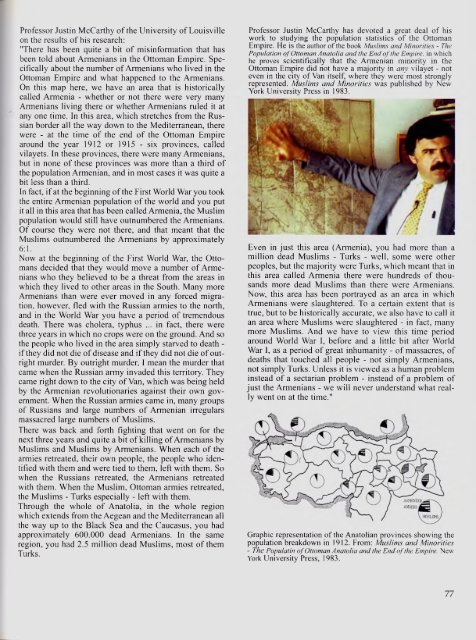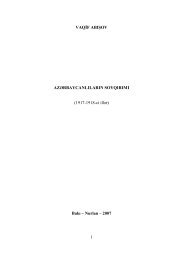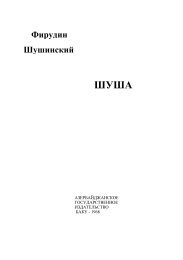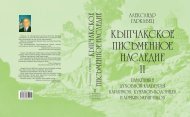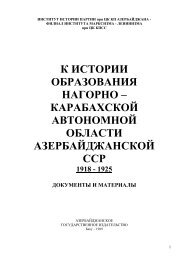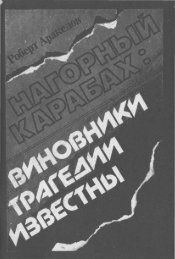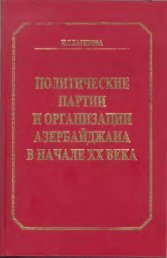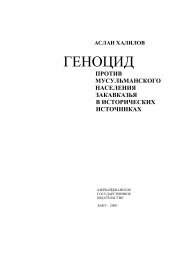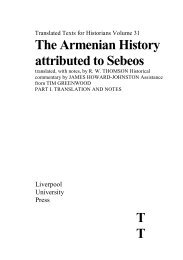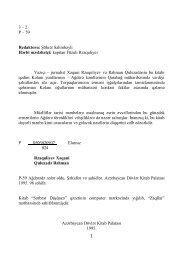ARMENIAN - Erevangala500
ARMENIAN - Erevangala500
ARMENIAN - Erevangala500
Create successful ePaper yourself
Turn your PDF publications into a flip-book with our unique Google optimized e-Paper software.
Professor Justin McCarthy o f the University o f Louisville<br />
on the results o f his research:<br />
"There has been quite a bit o f misinformation that has<br />
been told about Armenians in the Ottoman Empire. Specifically<br />
about the number o f Armenians who lived in the<br />
Ottoman Empire and what happened to the Armenians.<br />
On this map here, we have an area that is historically<br />
called Armenia - whether or not there were very many<br />
Armenians living there or whether Armenians ruled it at<br />
any one time. In this area, which stretches from the Russian<br />
border all the way down to the Mediterranean, there<br />
were - at the time o f the end o f the Ottoman Empire<br />
around the year 1912 or 1915 - six provinces, called<br />
vilayets. In these provinces, there were many Armenians,<br />
but in none o f these provinces was more than a third o f<br />
the population Armenian, and in most cases it was quite a<br />
bit less than a third.<br />
In fact, if at the beginning o f the First World War you took<br />
the entire Armenian population o f the world and you put<br />
it all in this area that has been called Armenia, the Muslim<br />
population would still have outnumbered the Armenians.<br />
O f course they were not there, and that meant that the<br />
Muslims outnumbered the Armenians by approximately<br />
6 : 1.<br />
Now at the beginning o f the First World War, the Ottomans<br />
decided that they would move a number o f Armenians<br />
who they believed to be a threat from the areas in<br />
which they lived to other areas in the South. Many more<br />
Armenians than were ever moved in any forced migration.<br />
however, fled with the Russian armies to the north,<br />
and in the World War you have a period o f tremendous<br />
death. There was cholera, typhus ... in fact, there were<br />
three years in which no crops were on the ground. And so<br />
the people who lived in the area simply starved to death -<br />
if they did not die o f disease and if they did not die o f outright<br />
murder. By outright murder, I mean the murder that<br />
came when the Russian army invaded this territory. They<br />
came right down to the city o f Van, which was being held<br />
by the Armenian revolutionaries against their own government.<br />
When the Russian armies came in, many groups<br />
of Russians and large numbers o f Armenian irregulars<br />
massacred large numbers o f Muslims.<br />
There was back and forth fighting that went on for the<br />
next three years and quite a bit o f killing o f Armenians by<br />
Muslims and Muslims by Armenians. When each o f the<br />
armies retreated, their own people, the people who identified<br />
with them and were tied to them, left with them. So<br />
when the Russians retreated, the Armenians retreated<br />
with them. When the Muslim, Ottoman armies retreated,<br />
the Muslims - Turks especially - left with them.<br />
Through the whole o f Anatolia, in the whole region<br />
which extends from the Aegean and the Mediterranean all<br />
the way up to the Black Sea and the Caucasus, you had<br />
approximately 600.000 dead Armenians. In the same<br />
region, you had 2.5 million dead Muslims, most o f them<br />
Turks.<br />
Professor Justin McCarthy has devoted a great deal o f his<br />
work to studying the population statistics o f the Ottoman<br />
Empire. He is the author of the book Muslims and Minorities - The<br />
Population of Ottoman Anatolia and the End of the Empire, in which<br />
he proves scientifically that the Armenian minority in the<br />
Ottoman Empire did not have a majority in any vilayet - not<br />
even in the city o f Van itself, where they were most strongly<br />
represented. Muslims and Minorities was published by New<br />
York University Press in 1983.<br />
Even in just this area (Annenia), you had more than a<br />
million dead Muslims - Turks - well, some were other<br />
peoples, but the majority were Turks, which meant that in<br />
this area called Armenia there were hundreds o f thousands<br />
more dead Muslims than there were Armenians.<br />
Now, this area has been portrayed as an area in which<br />
Armenians were slaughtered. To a certain extent that is<br />
true, but to be historically accurate, we also have to call it<br />
an area where Muslims were slaughtered - in fact, many<br />
more Muslims. And we have to view this time period<br />
around World War I, before and a little bit after World<br />
War I, as a period o f great inhumanity - o f massacres, o f<br />
deaths that touched all people - not simply Armenians,<br />
not simply Turks. Unless it is viewed as a human problem<br />
instead o f a sectarian problem - instead o f a problem o f<br />
just the Armenians - we will never understand what really<br />
went on at the time."<br />
Graphic representation o f the Anatolian provinces showing the<br />
population breakdown in 1912. From: Muslims and Minorities<br />
- The Populatin of Ottoman Anatolia and the End of the Empire. New<br />
York University Press, 1983.<br />
77


